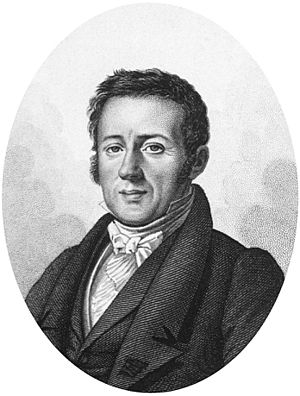René Lesson facts for kids
René-Primevère Lesson (born March 20, 1794 – died April 28, 1849) was a French surgeon, naturalist, and expert on birds (ornithologist) and reptiles (herpetologist). He is famous for his travels and for describing many new animal species.
Contents
A Life of Exploration and Discovery
René Lesson was born in Rochefort, France. When he was just sixteen, he started studying at the Naval Medical School in his hometown.
Lesson joined the French Navy during the Napoleonic Wars. He worked as a surgeon on different ships. In 1811, he was the third surgeon on a frigate called Saale. By 1813, he was the second surgeon on the Regulus.
A Voyage Around the World
In 1816, Lesson changed his job title to pharmacist. This change allowed him to join an amazing journey around the world! From 1822 to 1825, he sailed on the ship La Coquille (which means "The Shell") with Captain Duperrey.
During this trip, Lesson collected many natural history specimens. He worked with another surgeon, Prosper Garnot, and an officer named Jules Dumont d'Urville. While visiting places like the Moluccas and New Guinea, Lesson became the first naturalist to see birds of paradise in their natural home. Imagine seeing those beautiful birds for the very first time in the wild!
Sharing His Discoveries
After returning to Paris, Lesson spent seven years writing about the animals he found on the expedition. This huge work was part of the official report of the voyage.
He also wrote many other important books about animals, especially birds:
- Manuel d'Ornithologie (1828)
- Traité d'Ornithologie (1831)
- Centurie Zoologique (1830–1832)
- Illustrations de Zoologie (1832–35)
Lesson was especially interested in hummingbirds and birds of paradise. He published several books just about them:
- Histoire naturelle des oiseaux-mouches (1829–1831) – About hummingbirds.
- Histoire naturelle des Colibris (1831–32) – More about hummingbirds.
- Les trochilidées ou les colibris et les oiseaux-mouches (1832) – Even more about hummingbirds!
- Histoire naturelle des oiseaux de paradis et des épimaques (1835) – About birds of paradise.
He also described many new kinds of amphibians and reptiles.
Family and Later Life
On February 3, 1827, René Lesson married Clémence Dumont de Sainte-Croix. She was an artist who drew scientific pictures. Clémence and her sister, Zoë Dumont de Sainte-Croix, helped illustrate the plates in Lesson's books.
From 1831, Lesson worked as a professor of pharmacy. He received several promotions and became the highest-ranking naval pharmacist in Rochefort by 1835. His experience as a ship's surgeon helped him write a two-volume handbook for naval surgeons.
Lesson was recognized for his important work. He became a member of the Académie de Médecine in 1828 and later the Académie des Sciences in 1833. In 1847, he received the Légion d'honneur, a very important award in France.
Sometimes, René Primevère Lesson is confused with his brother, Pierre Adolphe Lesson (1805-1888). Pierre also went on an expedition on the ship Astrolabe (which was the Coquille renamed) from 1826 to 1829.
Amphibian and Reptile Discoveries
René Lesson described many new species of amphibians and reptiles. Here are some of the species he named that are still recognized today:
- Litoria aurea (Lesson, 1826) – The green and golden bell frog.
- Pleurodema thaul (Lesson, 1826) – The Chile four-eyed frog.
- Hylarana papua (Lesson, 1826) – The Papua River frog.
- Emoia cyanura (Lesson, 1826) – The copper-tailed emo skink.
- Lamprolepis smaragdina (Lesson, 1826) – The emerald tree skink.
- Liolaemus chiliensis (Lesson, 1826) – The Chilean tree lizard.
- Ornithuroscincus noctua (Lesson, 1826) – The moth skink.
- Varanus douarrha (Lesson, 1830) – A type of monitor lizard.
- Emoia atrocostata (Lesson, 1830) – The mangrove skink.
- Emoia cyanogaster (Lesson, 1830) – The green-bellied emo skink.
- Enyalius brasiliensis (Lesson, 1830) – The Brazilian fathead anole.
- Gehyra oceanica (Lesson, 1830) – The oceanic gecko.
- Microlophus peruvianus (Lesson, 1830) – The Peruvian coastal lizard.
- Micropechis ikaheca (Lesson, 1830) – The New Guinea small-eyed snake.
- Naja kaouthia (Lesson, 1831) – The monocled cobra.
- Crocodylus palustris (Lesson, 1831) – The mugger crocodile.
- Euphlyctis hexadactylus (Lesson, 1834) – The Indian bullfrog.
- Draco bourouniensis (Lesson, 1834) – The Buru flying lizard.
The "Counting by Elevens" Mistake
When Lesson returned from his voyage in 1825, he published a French translation of an article by a German botanist named Adelbert von Chamisso. In this article, von Chamisso incorrectly said that the number system in New Zealand was based on twenty.
Lesson added a note to this, saying it was a mistake. He wrote that the New Zealand number system was "undécimal" and that the English had spread this wrong idea. The word "undécimal" might have been a printing error, perhaps meant to be "un decimal" (meaning "a decimal" or base ten). However, it was understood to mean "counting by elevens," similar to how "duodecimal" means counting by twelves.
Over the next few years, Lesson and his friend Jules de Blosseville actually tried to make this "counting by elevens" idea seem true. They even published made-up number words for a base-eleven system. This incorrect idea spread and was mentioned by other scientists at the time. Lesson likely wrote an anonymous essay that gave more details about this supposed counting system, even naming specific places in New Zealand where the information was supposedly gathered.
Honours
A type of large kelp (a kind of seaweed) found in the southern Pacific Ocean was named Lessonia in René Lesson's honour in 1825. Later, another brown algae, Lessoniopsis, was also named after him in 1903.
See also
 In Spanish: René Primevère Lesson para niños
In Spanish: René Primevère Lesson para niños
- European and American voyages of scientific exploration
- Category:Taxa named by René Lesson
- Alleged use of base-11 in cultural number systems


